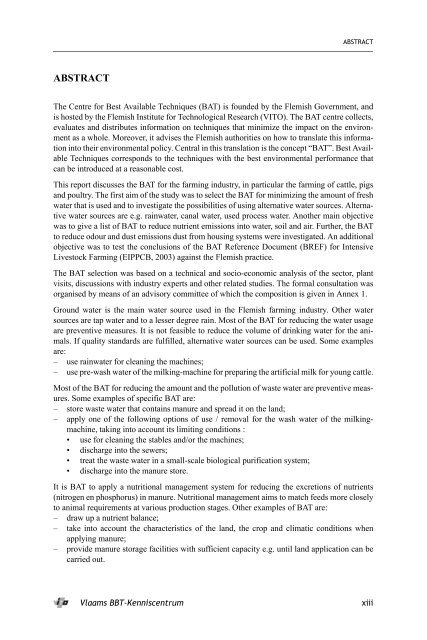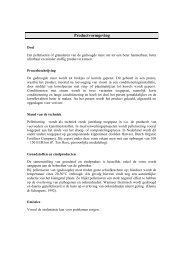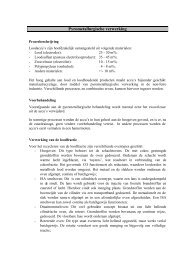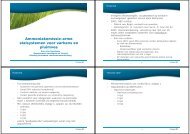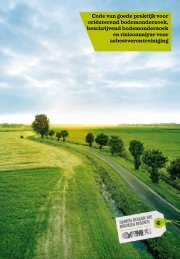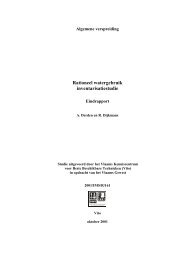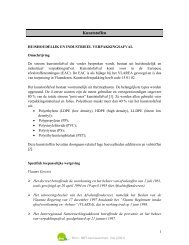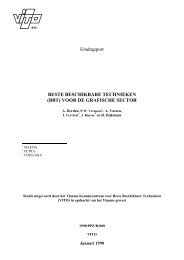- Page 1: Beste Beschikbare Technieken (BBT)
- Page 4 and 5: © Academia Press - Gent Eekhout 2
- Page 7: LEESWIJZER LEESWIJZER Hoofdstuk 1 I
- Page 10 and 11: INHOUDSTAFEL 2.6.1. Vlaamse wetgevi
- Page 12 and 13: INHOUDSTAFEL 4.5. Energie . . . . .
- Page 15: SAMENVATTING SAMENVATTING Het BBT-k
- Page 19 and 20: Hoofdstuk 1 INLEIDING 1.1. Beste Be
- Page 21 and 22: 1.1.3. Het Vlaams kenniscentrum voo
- Page 23: INLEIDING afweging laat ons toe de
- Page 26 and 27: HOOFDSTUK 2 0121 Rundveehouderij 01
- Page 28 and 29: HOOFDSTUK 2 Figuur 1: Bedrijfskolom
- Page 30 and 31: HOOFDSTUK 2 b. Varkenshouderij (An.
- Page 32 and 33: HOOFDSTUK 2 Opmerking Vanaf 2012 is
- Page 34 and 35: HOOFDSTUK 2 Deze telling vindt jaar
- Page 36 and 37: HOOFDSTUK 2 In Figuur 8 wordt de ev
- Page 38 and 39: HOOFDSTUK 2 BRON: An., 2004m Tabel
- Page 40 and 41: HOOFDSTUK 2 zeercrisis. De oude ref
- Page 42 and 43: HOOFDSTUK 2 Figuur 11: Evolutie lan
- Page 44 and 45: HOOFDSTUK 2 Figuur 14: Spreiding en
- Page 46 and 47: HOOFDSTUK 2 Tabel 8: Gemiddeld aant
- Page 48 and 49: HOOFDSTUK 2 De opvolgingsperspectie
- Page 50 and 51: HOOFDSTUK 2 Figuur 18: Evolutie ein
- Page 52 and 53: HOOFDSTUK 2 varkensvleesconsumptie
- Page 54 and 55: HOOFDSTUK 2 waarde worden opgeteld.
- Page 56 and 57: HOOFDSTUK 2 Figuur 23: Evolutie ink
- Page 58 and 59: HOOFDSTUK 2 maakt een deel van het
- Page 60 and 61: HOOFDSTUK 2 BRON: Claeys D., 2004 T
- Page 62 and 63: HOOFDSTUK 2 Tabel 17: Aard en belan
- Page 64 and 65: HOOFDSTUK 2 Tabel 18: Investeringen
- Page 66 and 67:
HOOFDSTUK 2 BRON: An., 2004o Tabel
- Page 68 and 69:
HOOFDSTUK 2 50 Vlaams BBT-Kenniscen
- Page 70 and 71:
HOOFDSTUK 2 de economie in 2002 18
- Page 72 and 73:
HOOFDSTUK 2 2.2.7. Conclusie De laa
- Page 74 and 75:
HOOFDSTUK 2 Er kunnen een aantal tr
- Page 76 and 77:
HOOFDSTUK 2 a. Interne concurrentie
- Page 78 and 79:
HOOFDSTUK 2 b. Macht van de leveran
- Page 80 and 81:
HOOFDSTUK 2 bankaangifte (vnl. van
- Page 82 and 83:
HOOFDSTUK 2 Vlarem I In bijlage 1
- Page 84 and 85:
HOOFDSTUK 2 Deze algemene milieuvoo
- Page 86 and 87:
HOOFDSTUK 2 grondwatervoorraden en
- Page 88 and 89:
HOOFDSTUK 2 len), AWZ 22 (voor de m
- Page 90 and 91:
HOOFDSTUK 2 Nk = a ( k × 0,0004) w
- Page 92 and 93:
HOOFDSTUK 2 5. Huisvesting De omzen
- Page 94 and 95:
HOOFDSTUK 2 • tegen 2007 erosie b
- Page 96 and 97:
HOOFDSTUK 2 Op het niveau van het V
- Page 98 and 99:
HOOFDSTUK 2 Tabel 23: Resultaten va
- Page 100 and 101:
HOOFDSTUK 2 biologische productie M
- Page 102 and 103:
HOOFDSTUK 2 • Lozingsbesluit bode
- Page 104 and 105:
HOOFDSTUK 2 • Verordening (EEG) n
- Page 106 and 107:
HOOFDSTUK 3 3.2. Voeder 3.2.1. Opsl
- Page 108 and 109:
HOOFDSTUK 3 2. brijbak: de biggen d
- Page 110 and 111:
HOOFDSTUK 3 3.3. Huisvesting (Gooss
- Page 112 and 113:
HOOFDSTUK 3 de melkstanden en de lo
- Page 114 and 115:
HOOFDSTUK 3 stromest, hoewel in som
- Page 116 and 117:
HOOFDSTUK 3 (5) volroosters In prin
- Page 118 and 119:
HOOFDSTUK 3 voor biggen (tocht is q
- Page 120 and 121:
HOOFDSTUK 3 De vleesvarkensstal is
- Page 122 and 123:
HOOFDSTUK 3 b) leghennen Bij leghen
- Page 124 and 125:
HOOFDSTUK 3 tinu te laten werken, d
- Page 126 and 127:
HOOFDSTUK 3 voor vloeibare mest •
- Page 128 and 129:
HOOFDSTUK 3 ceren en het aldus gesc
- Page 131 and 132:
BESCHIKBARE MILIEUVRIENDELIJKE TECH
- Page 133 and 134:
2. Reinigingswater voor stallen BES
- Page 135 and 136:
BESCHIKBARE MILIEUVRIENDELIJKE TECH
- Page 137 and 138:
milieu-impact BESCHIKBARE MILIEUVRI
- Page 139 and 140:
milieu-impact BESCHIKBARE MILIEUVRI
- Page 141 and 142:
voorraadreiniging BESCHIKBARE MILIE
- Page 143 and 144:
milieu-impact BESCHIKBARE MILIEUVRI
- Page 145 and 146:
BESCHIKBARE MILIEUVRIENDELIJKE TECH
- Page 147 and 148:
BESCHIKBARE MILIEUVRIENDELIJKE TECH
- Page 149 and 150:
varkenshouderij BESCHIKBARE MILIEUV
- Page 151 and 152:
BESCHIKBARE MILIEUVRIENDELIJKE TECH
- Page 153 and 154:
. Vervuiling van de run-off van de
- Page 155 and 156:
milieu-impact BESCHIKBARE MILIEUVRI
- Page 157 and 158:
BESCHIKBARE MILIEUVRIENDELIJKE TECH
- Page 159 and 160:
milieu-impact BESCHIKBARE MILIEUVRI
- Page 161 and 162:
BESCHIKBARE MILIEUVRIENDELIJKE TECH
- Page 163 and 164:
BESCHIKBARE MILIEUVRIENDELIJKE TECH
- Page 165 and 166:
BESCHIKBARE MILIEUVRIENDELIJKE TECH
- Page 167 and 168:
nummer waarneming N tot Ntot-efflue
- Page 169 and 170:
BESCHIKBARE MILIEUVRIENDELIJKE TECH
- Page 171 and 172:
BESCHIKBARE MILIEUVRIENDELIJKE TECH
- Page 173 and 174:
BESCHIKBARE MILIEUVRIENDELIJKE TECH
- Page 175 and 176:
BESCHIKBARE MILIEUVRIENDELIJKE TECH
- Page 177 and 178:
BESCHIKBARE MILIEUVRIENDELIJKE TECH
- Page 179 and 180:
Tabel 50: Broeikasgasemissies (CH4,
- Page 181 and 182:
BESCHIKBARE MILIEUVRIENDELIJKE TECH
- Page 183 and 184:
technische haalbaarheid BESCHIKBARE
- Page 185 and 186:
BRON: EIPPCB, 2003 BESCHIKBARE MILI
- Page 187 and 188:
in de pluimveehouderij: • stroois
- Page 189 and 190:
BESCHIKBARE MILIEUVRIENDELIJKE TECH
- Page 191 and 192:
BESCHIKBARE MILIEUVRIENDELIJKE TECH
- Page 193 and 194:
Diersoort Tabel 57: Overzicht van d
- Page 195 and 196:
BESCHIKBARE MILIEUVRIENDELIJKE TECH
- Page 197 and 198:
BESCHIKBARE MILIEUVRIENDELIJKE TECH
- Page 199 and 200:
BESCHIKBARE MILIEUVRIENDELIJKE TECH
- Page 201 and 202:
BESCHIKBARE MILIEUVRIENDELIJKE TECH
- Page 203 and 204:
BESCHIKBARE MILIEUVRIENDELIJKE TECH
- Page 205 and 206:
BESCHIKBARE MILIEUVRIENDELIJKE TECH
- Page 207 and 208:
technische haalbaarheid BESCHIKBARE
- Page 209 and 210:
BESCHIKBARE MILIEUVRIENDELIJKE TECH
- Page 211 and 212:
BESCHIKBARE MILIEUVRIENDELIJKE TECH
- Page 213 and 214:
economische haalbaarheid BESCHIKBAR
- Page 215 and 216:
technische haalbaarheid BESCHIKBARE
- Page 217 and 218:
technische haalbaarheid BESCHIKBARE
- Page 219 and 220:
milieu-impact BESCHIKBARE MILIEUVRI
- Page 221 and 222:
BESCHIKBARE MILIEUVRIENDELIJKE TECH
- Page 223 and 224:
BESCHIKBARE MILIEUVRIENDELIJKE TECH
- Page 225 and 226:
SELECTIE VAN DE BESTE BESCHIKBARE T
- Page 227 and 228:
SELECTIE VAN DE BESTE BESCHIKBARE T
- Page 229 and 230:
Tabel 61: Evaluatie van de beschikb
- Page 231 and 232:
Technisch Milieu BBT Economisch Glo
- Page 233 and 234:
Emissies van nutriënten naar water
- Page 235 and 236:
j. economische haalbaarheid bij bes
- Page 237 and 238:
Afval Technisch Milieu Techniek BBT
- Page 239 and 240:
SELECTIE VAN DE BESTE BESCHIKBARE T
- Page 241:
SELECTIE VAN DE BESTE BESCHIKBARE T
- Page 244 and 245:
HOOFDSTUK 6 kolom 3 ja: techniek is
- Page 246 and 247:
HOOFDSTUK 6 Perssappen en first flu
- Page 248 and 249:
HOOFDSTUK 6 voorstel - aanpassing V
- Page 250 and 251:
HOOFDSTUK 6 m. ondanks een positiev
- Page 252 and 253:
HOOFDSTUK 6 Op basis van dit regist
- Page 254 and 255:
HOOFDSTUK 6 Het opleggen van sector
- Page 256 and 257:
HOOFDSTUK 6 6.3.6. Geur- en stofemi
- Page 258 and 259:
BIBLIOGRAFIE An., Nageschakelde tec
- Page 260 and 261:
BIBLIOGRAFIE Goossens A., BBT veete
- Page 262 and 263:
BIBLIOGRAFIE Van Gansbeke S., Ammon
- Page 265:
LIJST DER AFKORTINGEN LIJST DER AFK
- Page 268 and 269:
BEGRIPPENLIJST effluent: uitgaande
- Page 270 and 271:
BEGRIPPENLIJST nutriëntenbalans: e
- Page 272 and 273:
OVERZICHT VAN DE BIJLAGEN Bijlage 1
- Page 274 and 275:
BIJLAGE 1 Contactpersonen proefcent
- Page 277 and 278:
Bijlage 2 WETGEVING Mestdecreet (19
- Page 279 and 280:
WETGEVING Gebied Uitrijverbodsperio
- Page 281 and 282:
GEDETAILLEERDE KOSTPRIJSBEREKENINGE
- Page 283 and 284:
REKENVOORBEELD Bijlage 4 REKENVOORB
- Page 285 and 286:
Omhullende constructie Beschrijving
- Page 287 and 288:
REKENVOORBEELD OMSCHRIJVING E Hoev.
- Page 289 and 290:
REKENVOORBEELD OMSCHRIJVING E Hoev.
- Page 291 and 292:
Tabel 68: Meetstaat vleesvarkens AE
- Page 293 and 294:
REKENVOORBEELD OMSCHRIJVING E Hoev.
- Page 295 and 296:
REKENVOORBEELD OMSCHRIJVING E Hoev.
- Page 297 and 298:
Tabel 69: Meetstaat vleesvarkens AE
- Page 299 and 300:
OMSCHRIJVING E Hoev. E.P. in € TO
- Page 301 and 302:
REKENVOORBEELD OMSCHRIJVING E Hoev.
- Page 303 and 304:
BIJLAGE 4 OMSCHRIJVING E Hoev. E.P.
- Page 305 and 306:
Bijlage 5 FINALE OPMERKINGEN FINALE
- Page 307:
FINALE OPMERKINGEN Deze paragraaf o


